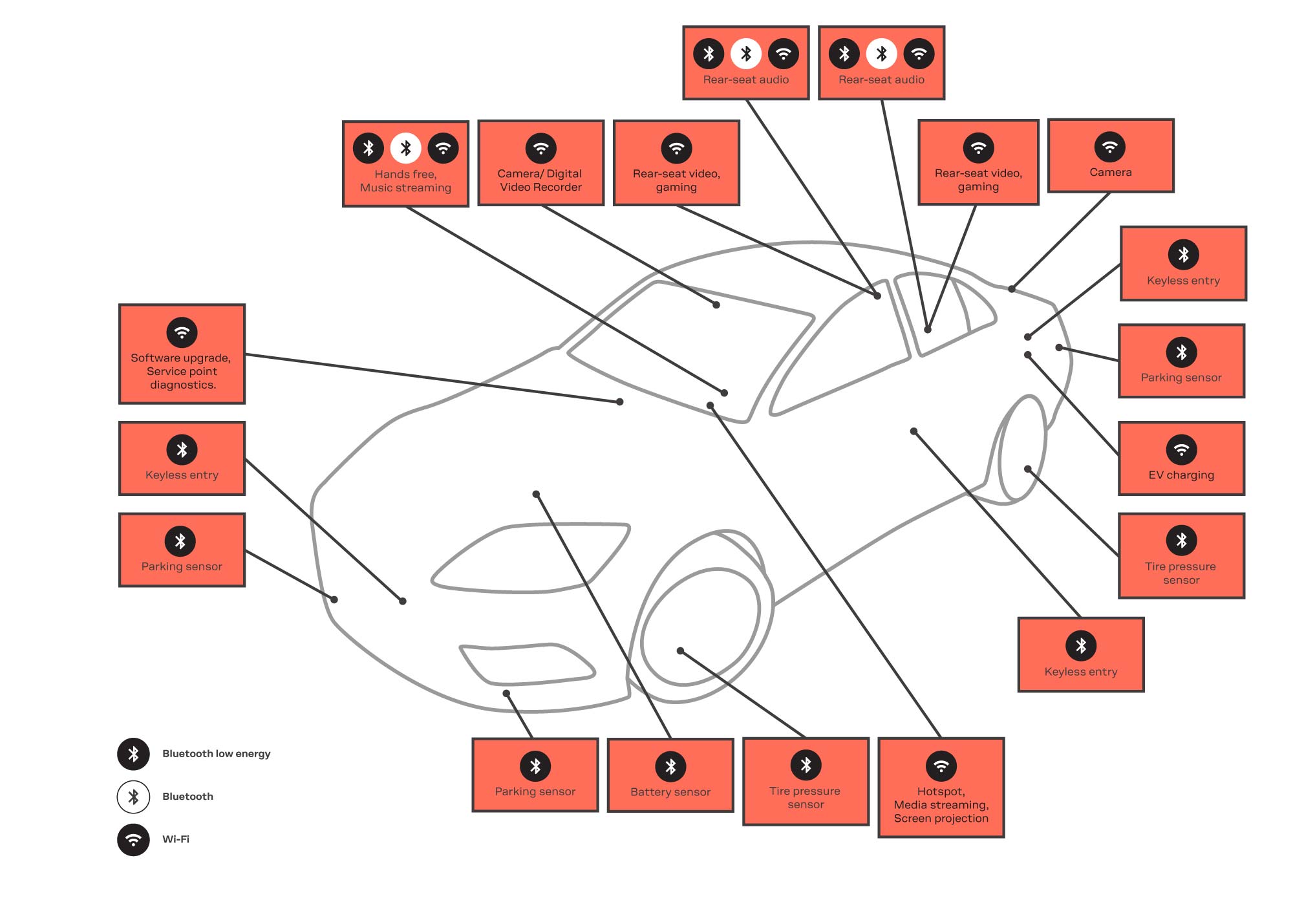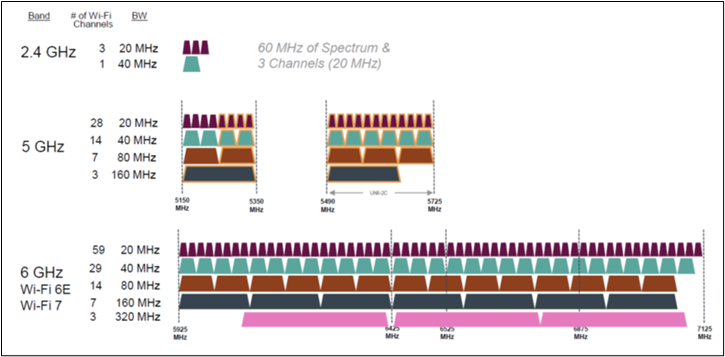
- Support portal
- Evaluation Kits and partner products
u-blox Support
- Product documentation
Documentation
- Investor relations
Investor relations
Tech
|
17 Feb 2023
Wi-Fi 6E - The next enabler of automotive applications

The modern car rolling off the production line is more connected than ever before and the complexity of onboard, connected applications has increased significantly over the last decade. Infotainment systems are now highly sophisticated, with data-intense audio and video-streaming apps coming as standard. Advanced Driver Assistance Systems (ADAS) act on data collected from a growing range of sensors within the vehicle, and today’s cars are increasingly capable of communicating with other road users, including vehicles, intelligent roadside infrastructure and pedestrians.
Needless to say, this increase in automotive connectivity has been accompanied by a growth in hunger for wireless data. Spotify alone can use up to 150 megabytes per hour, Netflix up to 7 gigabytes and some analysts estimate that a high-spec ADAS system can gather as much as 1.4 terabytes every hour. This dependence on wireless data will only grow as, according to Statista, a leading provider of market and consumer data, the size of the global connected car fleet is projected to almost quadruple by 2035, reaching an estimated 863 million units from its 2021 size of 236 million1

Connected automotive applications are currently heavily dependent upon Bluetooth® and Wi-Fi, with Bluetooth enabled audio streaming (A2DP) and multi-role, multi-purpose Wi-Fi and Wi-Fi–enabled screen sharing. This proliferation of connected automotive use cases and associated demand for wireless data threatens to cause signal congestion and risks degraded performance. With both Bluetooth and Wi-Fi operating in the 2.4 GHz band, there is significant competition for spectrum, although this is alleviated as more emerging Wi-Fi use cases operate on the 5 GHz band.
Wi-Fi 6 (aka IEEE 802.11ax) uses orthogonal frequency-division multiple access (OFDMA), a high-order digital modulation scheme which enables more users to communicate simultaneously. OFDMA also reduces the impact of multi-path fading of the higher frequency carrier signals, increasing the robustness of Wi-Fi 6 in outdoor environments. Data throughput is also significantly increased through a combination of multi-user multiple-input multiple-output (MU-MIMO) techniques and 1024 quadrature amplitude modulation (1024-QAM).
There are significant expectations on Wi-Fi 6 as an enabler for connected vehicles, with its increased spectral efficiency, up-to-fourfold increase in bandwidth capacity, and its increased flexibility, and broader coverage. This enhanced performance will either allow more clients to be served by each access point or enable new high bandwidth use cases such as ultra-high resolution video streaming.
Wi-Fi 6 also differs from previous releases of Wi-Fi as it focuses more on the quality of experience for multiple clients in crowded environments, rather than the needs of a few, who are mainly indoors. Particularly interesting for automotive use cases will be the improvements it brings in terms of longer range and better coverage outdoors.
Wi-Fi is set to remain a critical enabler of wireless connectivity within, beyond, and among vehicles, but current generations of Wi-Fi technology will require to be supplemented by the enhanced performance of Wi-Fi 6. At the same time automotive use cases offering enhanced levels of user experience, safety, and security will seek to leverage 4G and 5G cellular technologies for longer range and broader coverage with high data rates and low latency. Multi-mode capabilities will enable applications to “mix and match” connectivity. In urban areas with many cars and high demand for data, cellular and Wi-Fi could run concurrently whereas in situations such as charging stations or parking lots, Wi-Fi alone will be able to support the required data rates.

The capabilities of Wi-Fi are about to be significantly enhanced, with the imminent arrival of Wi-Fi 6E. This latest Wi-Fi release brings access to the 6 GHz band, allowing the migration of data traffic to higher frequencies, freeing up the 2.4 GHz band and enabling further expansion of low-cost, low-power Bluetooth connectivity. Wi-Fi 6E applications will have access to an additional up to 1200 MHz of spectrum in the 6 GHz band, with Wi-Fi 6E devices able to operate in 14 additional 80 MHz channels and 7 additional 160 MHz channels.

Since the FCC’s 2020 decision to open the 6 GHz band, the global roll-out of Wi-Fi 6E has gathered momentum, with over twenty-two countries adopting the new standard at the beginning of September 2022 and many more planning to do so. The Wi-Fi Alliance had projected that global sales of Wi-Fi 6E devices would exceed 350 million in 20222, a growing proportion of which were for automotive applications.
The enhanced capabilities of Wi-Fi 6E and its expanding availability will relieve the growing pressure on bandwidth in and around the modern connected vehicle and support multiple automotive applications, including infotainment units, telematics control units, and advanced driver-assistance systems. In such a rapidly changing market, OEMs and Tier 1s must decide on the best approach to implementation. As with previous generations of Wi-Fi a diversity of approaches can be expected, as the technology evolves in parallel with the increasing number of use cases but market pressures, as always, dictate accelerated, cost-effective development cycles. While an in-house solution may enable higher levels of customization, pre-certified modules, such as the recently announced JODY-W4 from u-blox, bring multiple advantages, reducing development time, simplifying PCB and device design and securing time to market, while reducing overall direct and indirect costs.
Already a recognized pioneer in automotive technology, u-blox is reinforcing their commitment to the market with the JODY-W4, the latest addition to its highly successful automotive, JODY portfolio. This pre-certified module is designed for Telematics Control Units (TCU) and In-vehicle Infotainment (IVI) applications, integrating both Wi-Fi 6E and Bluetooth LE Audio. One of the first modules to bring Wi-Fi 6E to market, the pioneering JODY-W4 addresses the Wi-Fi congestion problem, supporting quick and easy development of automotive applications using 6 GHz spectrum.
Wi-Fi 6E offers an antidote to increased signal crowding in the automotive environment. If you’re ready to seize the opportunities surrounding this new technology, then a pre-certified module such as the JODY-W4 can offer an accelerated development path.
To learn more about our u-blox JODY-W4 module, head over to the product page or contact your nearest sales representative.
1https://www.statista.com/statistics/1155517/global-connected-car-fleet-…
2https://www.wi-fi.org/news-events/newsroom/wi-fi-6-and-wi-fi-6e-drive-g…
If you would like any more information on this post, please fill in the attached form and one of our experts will get back to you as soon as possible
Peter Karlsson
Senior Director of Technology, Short Range Radio, u-blox
Fredrik Lonegard
Senior Product Marketing Manager, Short Range Radio, u-blox